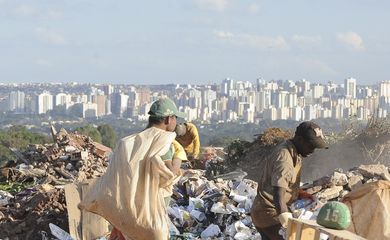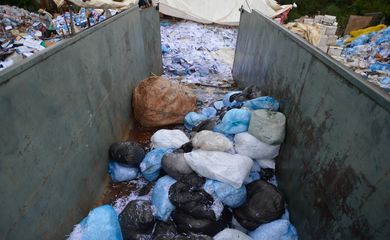More than 50% of Brazilians do not have access to sewage networks

The Ministry of Regional Development (MDR) presented, on Friday (17), data from the National Sanitation Information System (Snis) for 2020. Updated annually, the diagnosis gathers information provided by municipalities on the provision of sanitation services. water and sewage; urban solid waste management and drainage and rainwater management.

Based on indicators provided by 4,744 of the 5,570 city halls in the country, ministry technicians estimate that almost half of the population covered by the system does not have access to sewage networks. This means that, out of a total of 208.7 million Brazilians, 94.1 million do not have the service.
Considering municipal information, the percentage of people who have a sewage system is a little higher in the urban population: 63% against 55% of the general population (urban and rural). In general terms, the Southeast Region has the best coverage, with 80.5% of the population served by the sewage system. Then come the Midwest regions (59.5%); South (47.4%); Northeast (30.3%) and North (13.1%).
"This is our great challenge, our Achilles' heel, as we have practically half of the population without access to the sewage collection network", said Paulo Rogério dos Santos e Silva, deputy director of the Department of Technical Cooperation of the National Sanitation Secretariat, while remembering that the Legal Framework for Basic Sanitation, enacted in July last year, establishes the national goal of guaranteeing access to sewage collection and treatment for 90% of the Brazilian population by 2033.
The diagnosis presented today points to another challenge: only half of the collected sewage (50.8%) is treated. “It's one thing to collect sewage, another to treat it,” said Silva. "When we don't treat sewage properly, we end up generating more pollution, environmental degradation, and we fail to meet our objective."
Water
The number of city halls that provided information on water supply to the population – 5,350 – is higher than those that spoke out about the sewage network, reaching 96% of all 5,570 Brazilian municipalities. Thus, in this field, the survey captured the situation of 98.6% of the 208.7 million people covered by the Snis. Of these, 93.4% of those living in urban centers were served by public water supply networks in 2020.
In 5,337 municipalities, which represents 99.8% of the city halls that provided information, the service was provided by the public system. In 13 cities, alternative solutions were adopted, such as wells, cisterns and water trucks.
“Although we have an already quite significant urban service rate, when we look at total coverage [including rural areas], we realize that we are still far from universalizing the service, which is another major challenge,” said Silva. He recalled that, in this case, the national goal is to guarantee that at least 99% of the population – including those who live far from urban centers – have access to drinking water by 2033.
For the deputy director of the Department of Technical Cooperation of the National Sanitation Secretariat, distribution losses are also a problem. “If, on the one hand, we still have around 40 million people without access to treated water, on the other, we have very worrying indicators. Instead of decreasing, the losses increased, totaling, in 2020, 40.1%.” While, in the Center-West Region, the rate of losses from distributed drinking water is 34.2%, in the North, it reaches 51%; in the Northeast, at 46.3%; in the Southeast, 38.1% and, in the South, 36.7%.
According to the full publication available on the internet, the volume of water that is lost along the supply system has been growing continuously since 2015, when it was below 37%. "In quantitative terms, the index [of 40.1%] means that, of every 100 liters made available by service providers, only 59.9 are counted as used by consumers."
According to Silva, part of the increase is explained by the expansion of the researched sample, that is, the number of municipalities that forward information to the National Sanitation Information System, as well as any methodological changes. “Still, it's a big challenge.”
Waste
The picture of the treatment given to urban solid waste in the country is found in another publication , also available on the internet. Considering only the 4,589 municipalities (82.4% of the 5,570 existing in the country) that provided information to the Snis, the average rate of service coverage for the general population (urban and rural) reached 90.5% - reaching 98.7% of residents of urban areas. The system's sample covered 195.5 million Brazilians.
Total service rates (urban and rural areas) of household waste collection services varied widely according to region: 96% in the Southeast; 91.3% in the South and Midwest; 83% in the Northeast and 80.7% in the North.
Only 1,664 of the municipalities that responded to the survey had services for the selective collection of household solid waste in urban areas, with the collection of about 1.9 million tons of material, which is little compared to the 9.6 million tons of waste that, in 2020, were sent to landfills.
The Ministry of Regional Development estimates that, in 2020, among the municipalities that supplied the Snis base with data on solid waste, 1,545 dumps were in operation, against 652 landfills and 617 controlled landfills. “This number is still uncertain, but it demonstrates the size of the effort that needs to be made by governments to eradicate dumps. There is a lot of talk about the existence of 3,000 dumps [across the country], there are those who say 2,600, in short, based on the participation of Snis, we were able to identify 1,545 municipalities”, concluded Silva.
Text translated using artificial intelligence.






